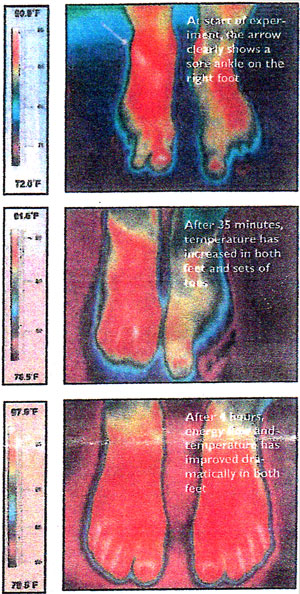Diabetes Wellness News – October 2004
Cynicism surrounds complementary medicines and the use of therapeutic magnets in particular. Many people espouse their health-improving properties, but do they really work?
A recent study in America, published in the Archives of Physical Medicine and Rehabilitation,  sought to provide some definitive data on the therapeutic benefits of magnetic insoles for diabetic neuropathy and other conditions.
sought to provide some definitive data on the therapeutic benefits of magnetic insoles for diabetic neuropathy and other conditions.
The research was lead by Dr. Michael Weintraub, Professor of Neurology at New York Medical College in Valhalla, who went into the study skeptical of the claim that therapeutic magnets work. While magnets are used by millions of people to treat a wide range of conditions including diabetic neuropathy and arthritis, there is a marked paucity of medical evidence supporting their effectiveness.
The study was given priority for publication because magnets have very few side effects and are potentially very useful for everyday usage. Despite his initial reservations, Dr. Weintraub is now adamant that magnets can relieve pain effectively.
The study found that there was evidence to support the claim that magnetic insoles offered greater relief from neuropathy than ordinary footsoles. One result showed that 71 percent of patients with the most severe foot problems reported a significant reduction in numbness and tingling, compared to 40 percent of patients who wore the placebo insole.
However, it remains unclear exactly how the magnets may produce their therapeutic effects. Sceptics are quick to point out that while the magnets did appear to reduce pain, they did not eliminate it or address the root of the problem. This said, they concede that if magnetic insoles aid recovery for particular patients they would welcome their use as a complementary therapy, because they have very few side effects.
Independent studies were conducted by an independent thermal imaging company in Canada, called Thermografix Consulting Corporation, and results have been very promising (see the pictures on the right). DRWF spoke to one patient , with diabetic neuropathy who has been trying the magnetic foot insoles for a short period of time. She said, “I have seen small improvements in my diabetic neuropathy at my last check, with circulation improving in both my feet. Having suffered with cold feet for years when I wear the insoles my feet become lovely and warm. The magnets have also helped to ease the arthritis in my knee.”
Peripheral neuropathy in the arms and legs is the most common form of nerve damage to be found in people with diabetes and can lead to extreme pain, pins and needles and difficulty walking. If you suffer with these symptoms you should consult your GP.
DRWF does not specifically endorse or recommend the use of magnets for therapeutic use on diabetic neuropathy and emphasises that you should not use these magnets if you are pregnant or have a pacemaker. You should also consult your GP before embarking on any complementary therapy.
Everyone who has diabetes should have their feet checked regularly at a specialist diabetes foot clinic.
These thermal imaging pictures taken by Thermografix Consulting Corperation in Canada, reveal the dramatic rise in energy flow and temperature during exposure to the magnetic foot insoles. After 4 hours, temperature levels have risen by nearly 8 degrees fahrenheit!
Pictures reproduced with kind permission from Thermografix Consulting Corp.
What The Experts Say…
Emma Holland, Specialist Neuropathy Nurse, says, “I am fully supportive of complementary therapies for help in painful neuropathy as many of the tablet treatments do have an array of side effects. I have had some patients where it has really helped and they ‘swear by them’. One concern, as with any extra innersole, is that it will make the shoe ‘tighter’ as well as raise the foot in the shoe and the ‘cutting in’ of innersoles needs to be carefully performed so as not to let the innersole slip around and potentially cause an ulcer. A large toe box of the shoe is usually required.”
Sara Moore, Diabetes Specialist Nurse says, “These magnets give people who are suffering from painful neuropathy an alternative treatment which is good. I would however say to anybody who is interested in trying any complementary therapy, do not stop your conventional treatment and make sure you see your doctor first to check if it is safe for you.”
For more information contact Elaine Connelly directly, or visit www.nikken.com/elaineconnelly for products.


